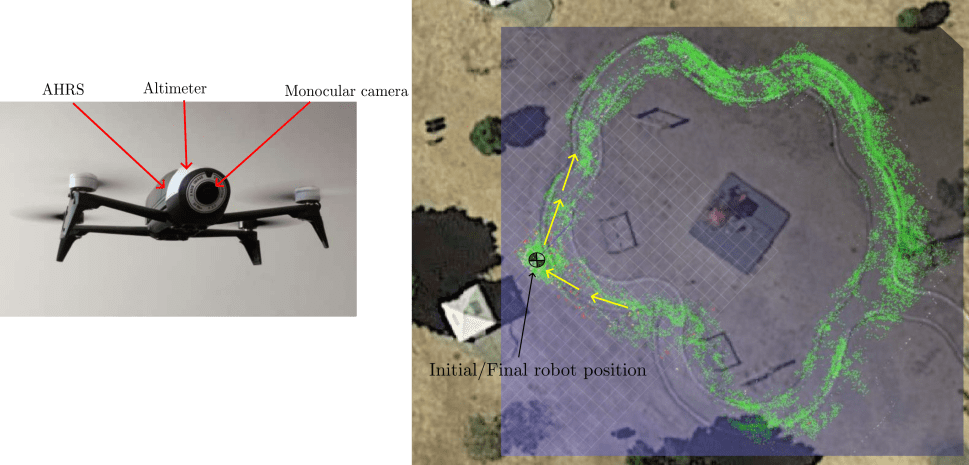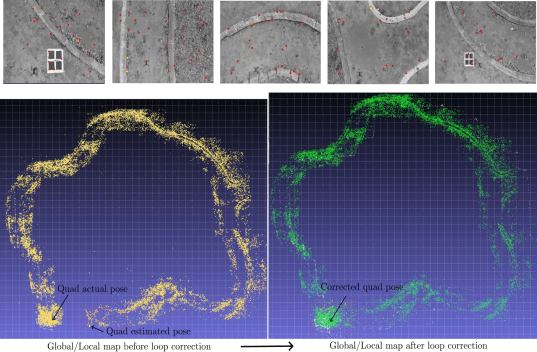Ros 2 implementation of the visual-based SLAM approach described in papers:
Monocular-Based SLAM for Mobile Robots: Filtering-Optimization Hybrid Approach, R Munguia, JC Trujillo, G Obregón-Pulido, CI Aldana, Journal of Intelligent & Robotic Systems 109 (3), 53.
A Hybrid Visual-Based SLAM Architecture: Local Filter-Based SLAM with KeyFrame-Based Global Mapping, R Munguia, JC Trujillo, E Guerra, A Graum Sensors 22 (1), 210.
The Hybrid VSLAM is composed of the following ROS 2 components and nodes (See https://docs.ros.org/en/galactic/Concepts/About-Composition.html):
ROS 2 components:
- Local SLAM (Implemented). The local SLAM component implements a filter-based visual-based SLAM system with state vector-size bounded to maintain real-time operation. By itself, this component produces up-to metric scale (world referenced) estimates of both, the robot state, and a local map of features. But in this case, since old features are removed from the vector state, to maintain real-time operation, previously visited areas of the environment can not be recognized, and thus the accumulated position drift can not be corrected by the same process alone.
- Global SLAM (Implemented). The Global SLAM component takes as input Key-frames produced by the local SLAM process to create and maintain a global and persistent map of the environment as well as correct the accumulated drift when loops are detected. This component makes use of optimization-based techniques such as bundle adjustment and graph-based SLAM.
- Plot (Implemented). The plot component implements a 3d scene of the robot's pose and trajectory as well as a map of visual features.
- Dataset (Implemented). This component emulates an actual robot driver by reading the dataset files and publishing the robot sensor data to ROS topics.
ROS 2 nodes:
- Keyboard (Implemented). Implements a simple command-line interface to interact with the Hybrid VSLAM application.
Dependencies (Tested in: Ubuntu 20.04):
1.- ROS 2 (Galactic), https://docs.ros.org/en/galactic/index.html
2.- Armadillo C++ library (tested with version 11.0.1), http://arma.sourceforge.net/ . Armadillo requires BLAS/OPENBLAS and LAPACK libraries installed
3.- OpenCV with extra modules installed (opencv_contrib) (tested with OpenCV version 4.2.0), https://opencv.org/ The following OpenCV contrib modules are also required or recommended: - VIZ (Required). VIZ requires VTK support (tested with version 8.1.0). - SFM (Recommended). For SFM dependencies check: https://docs.opencv.org/4.x/db/db8/tutorial_sfm_installation.html Note. For compilling OpenCV with SFM, Ceres solver library http://ceres-solver.org/ version < 2.0 is required (tested with 1.14).
4.- GTSAM c++ library (tested with version 4.1.1) https://gtsam.org/
Usage:
1.- Source the ROS 2 installation (in the root project folder):
foo@bar:~/home/Hybrid_VLSAM$ source /opt/ros/galactic/setup.bash
2.- Use colcon to build the "interfaces" package (this will be needed to do before building the other packages):
foo@bar:~/home/Hybrid_VLSAM$ colcon build --packages-select interfaces
3.- source the overlay:
foo@bar:~/home/Hybrid_VLSAM$ . install/setup.bash
4.- Use colcon for compiling the all the other packages :
foo@bar:~/home/Hybrid_VLSAM$ colcon build
5.- Reassemble and extract the sample dataset included in folder /Dataset_sample:
foo@bar:~/home/Hybrid_VLSAM/Dataset_sample$ cat dataset.tar.gz* | tar xzvf
6.- In a text editor open the file "params.yaml" located in the folder "config", and set the parameter "Dataset_path:" with the absolute path of the extracted dataset folder. Example:
Dataset_path: /home/Hybrid_VLSAM/Dataset_sample/2023-3-27-11-47/
7.- In the root project folder open a terminal and source the overlay:
foo@bar:~/home/Hybrid_VLSAM$ . install/setup.bash
8.- In the same terminal run the Hybrid SLAM using the launch file "launch/slam.launch.py". At this point, a graphical interface must be opened.
foo@bar:~/home/Hybrid_VLSAM$ ros2 launch launch/quad_slam.launch.py
9.- In the root project folder open a second terminal and source the overlay:
foo@bar:~/home/Hybrid_VLSAM$ . install/setup.bash
10.- Run the keyboard interface node:
foo@bar:~/home/Hybrid_VLSAM$ ros2 run keyboard keyboard_node
At this point, the following menu must appear in the console:
| Dataset commands :
| 'q' to quit.
| 'p'-> Play/Pause r-> Reset
| '-'-> zoom out '+' -> zoom in '1'-> x-y view '2' -> x-z view '3'->y-z view
| '8'-> view up '5' -> view down '4'-> view left '6' -> view right 'c'-> clear plot
11.- Press the key "p".
Notes on the sample dataset: The parameters can be modified in the configuration file /config/quad_params.yaml to change the results and performance of the method.

